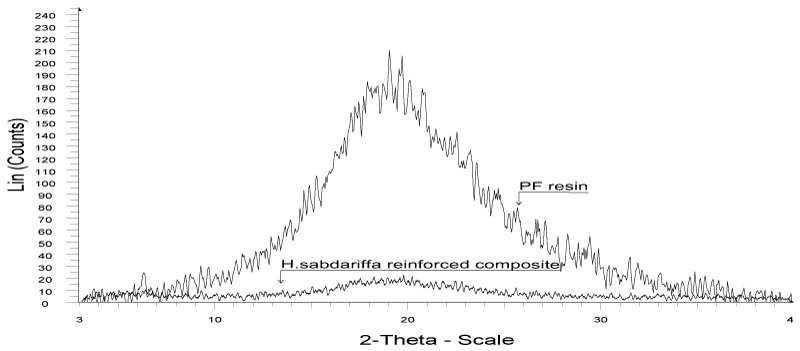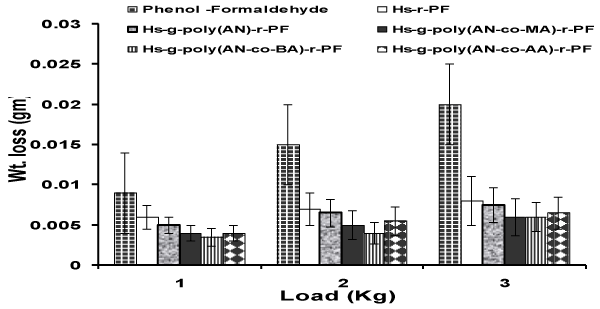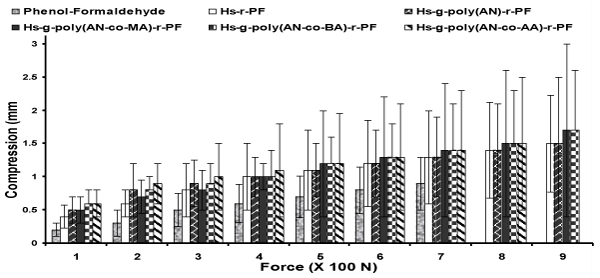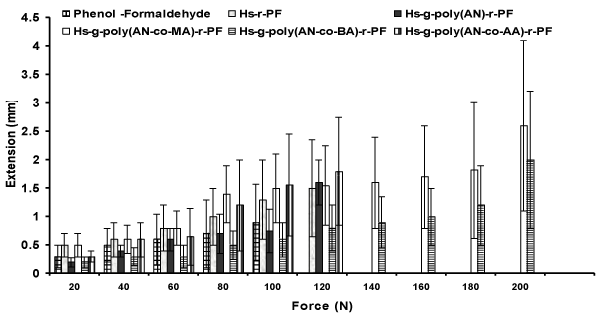Research Article Open Access
Fabrication and Physico-chemico-thermo-echanical Accreditation of Green Composite
| Ashish Chauhan* and Balbir Kaith | |
| Department of Chemistry, Dr. BR. Ambedkar National Institute of Technology, Jalandhar 144 011 (Pb), India | |
| Corresponding Author : | Ashish Chauhan Department of Chemistry Dr. BR. Ambedkar National Institute of Technology Jalandhar, India E-mail: aashishchauhan26@gmail.com |
| Received: December 10, 2012; Accepted: January 23, 2013; Published: January 25, 2013 | |
| Citation:Chauhan A, Kaith B (2013) Fabrication and Physico-chemico-thermomechanical Accreditation of Green Composite. J Bioremed Biodeg 4:179. doi:10.4172/2155-6199.1000179 | |
| Copyright: © 2013 Chauhan A, et al. This is an open-a ccess article distributed under the terms of the Creative Commons Attribution License, which permits unrestricted use, distribution, and reproduction in any medium, provided the original author and source are credited. | |
Related article at Pubmed Pubmed  Scholar Google Scholar Google |
|
Visit for more related articles at Journal of Bioremediation & Biodegradation
Abstract
The use of synthetic glass fiber as reinforcement is hazardous and its degradation is not easy, although these composites are useful for various applications. Hibiscus sabdariffa (Sorrel) has high (73.9%) cellulose content, tensile strength, and is present in abundance in nature through-out the world, but it is fragile and weather prone, that can be improved by graft copolymerization. Sorrel stem fiber was graft copolymerized with binary vinyl monomeric mixtures that transformed the properties and behavior of the fiber. These physico-chemico-thermally resistant graft co-polymers were then used as reinforcement in phenol-formaldehyde polymer matrix, and subjected to characterization and evaluation by advanced technique. Mechanical potential such as tensile strength, compressive strength, wear resistance, modulus of elasticity, modulus of rupture, stress at the limit of proportionality and hardness were screened to compare the change with the phenoplast. These fibers reinforced bio-composites exhibited physicochemico- thermal resistance and improved mechanical strength for better scientific and industrial applications. The graft copolymerization of waste biomass caused transformation in the properties of the fiber, and made it useful for reinforcement in polymer matrix that improved its bioremediation and biodegradation
| Keywords |
| Hibiscus sabdariffa; Graft-copolymers; Vinyl monomer; Reinforcement |
| Introduction |
| Composites are the wonder material that made man its slave. The use of synthetic glass fiber as reinforcement in composite has raised numerous problems and set a debate in scientific community for its use. It has led to a search for alternate material to be used as reinforcement. The use of natural fiber is one of the options, but the natural fiber is fragile and prone to weathering, so these cannot be used as such, unless chemically treated. Graft copolymerization is an excellent technique for incorporation of new and desired properties into the fiber, without drastically affecting the basic properties of the substrate. It imparts additional properties such as thermal and chemical resistance to the naturally existing back-bone for their use in various fields. Renewable natural resource existing as fibers, such as flax, jute, ramie and pine needle are principally suitable as reinforcement materials, because of their relatively high strength and stiffness in industries such as automobile, packaging and construction materials, to satisfy economic and ecological aspects. Various polysaccharides such as cellulose, starch, chitosan, guar-gum and psylium have been modified for their use in metal ion-sorption, drug delivery and water absorption studies. Moreover, these polymeric materials have been extensively used in agricultural and membrane technology. These studies have shown that these natural polymers are very efficient, and of great significance in water treatment processes due to biodegradability and cost effectiveness [1-5]. |
| Sorell has attained prominence as a jute substitute and attempts are being made to extend its cultivation in areas, which are not favorable for jute cultivation. Phenoplasts have a wide range of applications as lacquer, varnish, molding compounds, laminate for wall panel, and table top. In the recent times, many successful efforts have been made to prepare Phenol-Formaldehyde (PF) composites, and to increase its mechanical potential by using different reinforcements (r), like wood particle, hemp scotch, banana fiber and cellulose fiber [6,7]. The versatility of graft copolymerization and fiber reinforced composites inspired the thoughts to implement it onto virgin Hibiscus sabdariffa (Hs) stem fiber, using Acrylonitrile (AN) as primary monomer, and MA, BA, AA as secondary monomer for use in binary vinyl monomeric mixture in ceric ammonium nitriate-nitric acid initiator system. These graft copolymer were then used as reinforcement in polymer matrix based resin to fabricate green composites. The phenoplast, Hs-r-PFcomposite, Hs-graft copolymer- reinforced-PF composites, were then characterized and evaluated for physico-chemico-thermo-mechanical competence that remains unexplored. These advanced composite were formed by bio-transformation that improved the biodegradation of the composites. |
| Experiment |
| Materials |
| H. sabdariffa fiber was obtained from the Department of Agronomy, Chaudhary Sarwan Kumar Himachal Krishi Vishwavidyalaya, Palampur (H.P.), India. AN, BA, MA, AA monomers (Merck), Formaldehyde (CDH, India), Phenol and ceric ammonium nitrate (s. d. fine-Chem, Pvt. Ltd, Mumbai, India) were used as received. H. sabdariffa fiber was purified through soxhlet extraction in acetone for 72 hours. |
| Characterization |
| IR spectra of the sample were recorded with Perkin Elmer Fourier Transform Infrared (FTIR) spectrophotometer, using KBr pellets (Sigma Aldrich). Scanning Electron Micrographs (SEM) of the composites were obtained by using Electron Microscopy Machine (LEO 435-25-20). Thermogravimetric and differential thermal analysis were performed on thermal analyzer (LINSEIS, L-81 11). X-ray diffraction studies were performed on X-ray diffractometer (Bruker D8 Advance), under ambient conditions using Cu Kα (1.5418°A) radiation, Ni-filter, and scintillation counter as detector at 40 KV and 40 mA, on rotation between 13°-25° at 2θ scale at 1 sec. step size and increment of 0.01 degree with 0.5° or 1.0 mm of divergent and anti-scattering slit. The sample holder was made of PMMA and consisted of round central cavity. Outer diameter of the holder was 50 mm, central cavity had a diameter of 25 mm, which retained the sample height upto 1 mm and the holder height was 8.5 mm. Composites were prepared in Compression Molding Machine (Santec. India Ltd.). Wear resistance testing was carried-out on Wear and Friction Monitor (DUCOM, 20LE). Tensile and Compressive strength of samples were tested on Universal Testing Machine (HOUNSFIELD, H25KS). |
| Graft copolymerization |
| Graft copolymerization of the monomer onto H. sabdariffa was carried-out for the optimization of different reaction conditions, like reaction time, reaction temperature, monomer concentration, concentration of initiator system and pH, in order to obtain maximum graft yield. The fiber (0.5 g) was activated by swelling in 100 ml of the distilled water for 24 hours. Mixture of Ceric Ammonium Nitrate (CAN) and conc. HNO3 mixture was slowly added to the reaction medium, under continuous stirring, followed by the addition of a definite ratio of binary vinyl monomeric mixture. The reaction was carried-out at a definite temperature for a particular time interval. On completion of the reaction, the homopolymers, i.e. poly(AN), poly(AN-co-MA), poly(AN-co-BA), and poly(AN-co-AA) were removed on extraction with di methyl formamide, acetone, methanol, chloroform and water. The graft co-polymer was dried at 50°C, till a constant weight was obtained. The percent grafting (Pg) was shown in equation 1 [1-4]: |
 (1) (1) |
| Where Wf=final weight of the fiber, Wi=initial weight of the fiber. |
| Preparation of the resin |
| Phenol-formaldehyde resin was prepared, as per the method reported earlier. Different ratios of P-F were optimized with respect to their mechanical behavior, so as to obtain high mechanical strength. P: F ratio of 0.75: 1.0 was found to be the optimum ratio that exhibited better mechanical properties [8]. |
| Preparation of the composites |
| The H. sabdariffa stem fiber was mixed with P-F resin, using different fiber: resin ratios. The mixture was placed in the mold with dimensions: 40-80 mm length, 5×5 mm cross section. Degasification of sample was carried-out in Compression Molding Machine, and the samples were kept for curing at 120°C for 10 minutes under 400 kg/cm2 pressure. Fiber: resin ratio of 12.7: 87.3 was found to exhibit better mechanical properties. In each case, the number of replications used for the determination of mechanical properties was three. Tests were conducted under ambient laboratory conditions (35°C and 50% RH) [8]. |
| Mechanical evaluation |
| Wear test: Wear test was carried-out on DUCOM 20 LE .Wear and Friction machine performed the function, as per ASTM D 3702. Wear resistance test were conducted against hardened steel disc, having hardness of 60 HRC and roughness Ra: 0.5 μm. Samples for wear test were held against rotating counter surface, adjusted at 500 r. p. m. and load of 1-3 kg. Each test was conducted for 5 minutes of sliding, and loss of weight was taken as a measure of wear [4,8]. |
| Tensile strength test: Tensile strength test were carried-out as per ASTM standard D 3039. The composite sample of 8 cm length was clamped between the two jaws. Each end of the jaws gripped 2 cm of the sample. Rest of the 4 cm sample was used to study the tensile behavior. Readings for force and extension were set at zero. The test was conducted at constant strain rate of the order 5 mm/min. Tensile stress was applied till the failure of the sample and the load extension of the curve was obtained [4,8]. |
| Compressive strength test: Compressive strength of the sample was studied by following the procedure described in ASTM standard D 3410. Composite sample of 4 cm length was held between two platforms, and the strain rate was fixed at 2 mm/min. Initial readings for force and compression were set to zero. The compression strain was applied till the failure of the sample, and the total compression per unit force was recorded [4,8]. |
| Modulus of Rupture (MOR)/flexural strength and Modulus of Elasticity (MOE)/Young’s modulus: MOR and MOE were determined according to ASTM D 790, and were calculated using the equations 2 and 3 [8]: |
 (2) (2) |
 (3) (3) |
| Where P=peak load, L=length of the sample, b=width of the sample and d=thickness of the sample, P1=load at the limit of proportionality and y=rate of bending. |
| Stress at the limit of Proportionality (SP): Stress at the limit of proportionality was calculated, by using the equation 4 [8]: |
 (4) (4) |
| Where P1=load at the limit of proportionality, L=length of the sample, b=width of the sample, and d=thickness of the sample. |
| Hardness: Hardness of the composites was tested using Rockwell Hardness tester (Balancing Instrument and Equipments (Miraj) Pvt. Ltd., Model-TSM), using B- scale, 100 Kg as major load and 10 Kg as minor load, with 1/16 inch indenter steel ball measured in HRB [8]. |
| Physico-Chemical Evaluation |
| Moisture absorption study: Moisture absorbance studies at various relative humidity levels were carried out as per the method reported earlier [1]. Moisture absorbance percentage was calculated by placing a known weight (Wi) of dry grafted and ungrafted samples in a humidity chamber for about two hours, and then the final weight (Wf) of the samples exposed to different relative humidities, ranging from 30-90% were taken. The % moisture absorbance was calculated from the increase in initial weight by the equation 5 [1]: |
| |
| Acid and base resistance: Acid and base resistance was studied by placing a known weight (Wi) of dry grafted and ungrafted samples in fixed volume (50 ml) of 1N HCl and 1N NaOH, and the final weights (Wf) of the samples were observed after 72 hours [2-5]: |
 (6) (6) |
| Results and Discussion |
| Ceric ammonium nitrate used as source of ceric ion, in presence of concentrated nitric acid, plays an important role during graft copolymerization. Because of large size [Ce-O-Ce]6+ ion, it is unable to form complex with the fiber, whereas, in presence of HNO3, more and more of Ce4+ and [Ce (OH)3]3+ ions are formed, and these ions easily undergo complex formation with the hydroxyl groups of fiber. Ceric ion forms the chelate complex with the cellulose molecule, through C-2 and C-3 hydroxyl groups of the anhydro glucose unit. Transfer of the electron from the cellulose molecule to Ce (IV) would follow, leading to its reduction to Ce (III), breakage of the bonds at C-2 and C-3, resulting in the formation of the free radical sites Ceric ion forms complex with the cellulose through C-2 and C-3 hydroxyl groups of the anhydro glucose unit. Graft yield and homo-polymer formation have been found to the functions of both the monomer and initiator concentration [1,9]. |
| Optimization of different reaction parameters and effect of binary vinyl monomeric mixture |
| Parameters like temperature, time, pH, concentrations of CAN, HNO3 and AN were optimized to be: temperature: 35°C, time: 180 minutes, CAN: 3.31×10-4 mol/L, nitric acid: 7.32×10-3 mol/L, acrylonitrile: 4.56×10-3 mol/ L, and pH: 7.0 yielded a %G of 28, (± SD: 3.55; ± SE: 2.06), [1], after screening over a range of parameters. |
| Acrylonitrile as a principal monomer has all the needed characteristic for grafting onto H. sabdariffa backbone, like relative high reactivity, suitable chemical properties [high Kt, Kp/Kt,low CM (0.10×104 at 25°C)], but the high solubility of the monomer in the aqueous medium markedly effected the Pg, even at high concentration. These effects were markedly decreased by MA (Pg : 150), with reactivity ratio [1.02 + 0.02: 0.70 + 0.02 (50°C) as r1: r2], followed by BA (Pg: 132), reactivity ratio [1.02 + 0.02: 0.70 + 0.02 (50°C) as r1: r2]. The deficient characters of AN as monomer for grafting are not counteracted by binary vinyl monomers like acrylic acid. Moreover, the reactivity ratio was not favorable, hence, it further decreased the Pg (32.28) (Table 1). However, many other factors determine the graft yield like the type of fiber, swelling, number of active sites; the nature and amount of the solvent and temperature of polymerization strongly influence the reactivity ratios. In absence of monomer rich phase, the diluents will compete with the monomers for adsorption sites. The amount of adsorption will depend upon the total amount of surface area present, and this in turn, is dependent upon the rate of stirring. Physical factors like mixing efficiency determine the melt temperature, the pressure, solubility of the initiator, and the monomer. Elevated temperature favors the degradation, reduces the initiator half life, modifies the rate or specificity of the reaction, influences the solubility, and rheological parameters [1,10-12]. |
| Characterization |
| FTIR and SEM: The IR spectrum of the P-F resin showed peaks at 3422.0 cm-1 (–OH stretch), 2920.2 cm-1 (C-H aromatic stretch), 1609.9 cm-1 and 1508.6 cm-1 (C=C stretch). Other peaks were found at 1465.0 cm-1 (CH2 bend) and 1235.0 cm-1 (C-O stretch of phenol). In SEM, the PF resin and Hs-reinforced-PF composite distinguish the change in surface morphology brought about by the reinforced fiber to the phenoplast [Figures 1a and 1b]. The randomly oriented fiber and graft copolymers improved the mechanical strength. |
| XRD studies: The XRD overlay of the PF resin and the Hs-reinforced PF resin is given in figure 2 that clearly shows a distinct increase in amorphous content, after reinforcement with semi-crystalline cellulose fiber. |
| Thermal evaluation: The TGA results of the P-F composite (Table 2), showed 500°C and 600°C as the initial decomposition temperature and final decomposition temperature, respectively. The percentage weight loss during this decomposition was found to be 26.61%, in the temperature range of 50-500°C, while it was 73.39% during the final decomposition, in the temperature range of 500-600°C. The higher initial and final decomposition temperature could be due to three dimensional network structure of the thermoset. The DTA showed prominent exothermic peaks at 551 °C (150 μV), that corresponds to the major decomposition due to irreversible decomposition of the crystallites, between 500-600°C as a function of temperature, respectively. The IDT, FDT of fiber reinforced composites has increased due to strong fiber matrix interaction. The grafted monomer acts as coupling agent, and elevates the decomposition temperature. |
| Physico-chemical evaluation |
| The physico-chemico-thermally resistance graft copolymers was reinforced in the phenoplast, and evaluated for the change in behavior. |
| Moisture absorbance studies: It was found that graft co-polymerization of vinyl monomer onto H. sabdarifa had a great impact on the moisture absorbance behavior (Table 3). It has been observed that with increase in graft yield, there was a decrease in percent moisture absorbance. This was due to blocking of sites, vulnerable for moisture absorbance with vinyl monomer chains, thereby, converting the fiber less sensitive to moisture. Similarly, the graft fiber reinforced composite complex, showed a marked decrease in moisture absorbance due to intricate three dimension fiber matrix complex, where the monomer acted as a coupling agent, in comparison to the P-F resin [1-5]. |
| Chemical resistance studies: It has been observed that acid-base resistance of the fiber increased with increase in percent grafting. This is due to the fact that poly (vinyl) chains grafted onto H. sabdariffa fiber have less affinity for 1 N HCl and 1N NaOH, as compared to free hydroxyl groups present in ungrafted fiber. Therefore, the resistance of fiber towards acid-base was found to increase with the incorporation of poly (vinyl) chains on the active sites of the backbone. Similarly, the graft fiber reinforced composite complex showed a marked chemical resistance due to strong fiber matrix complex formation, in comparison to the P-F resin (Table 3) [1-5]. |
| Mechanical evaluation |
| P: F ratio of 0.75: 1.0 in Hs-r-PF composites with fiber to matrix ratio of 12.7: 87.3 depicted better mechanical behavior, when subjected for the evaluation of different mechanical test, as compared to the P-F resin. Inadequate amount of fiber within the polymer matrix did not support the composite under continuous stress and strain, whereas the excess of the fiber led to debonding. Loading of the matrix beyond optimum ratio decreased the stiffness and impaired the needed fiber matrix interaction (Tables 4-7 and Figures 3-5) [13,14]. |
| Thus, it is evident from the results that H. sabdariffa fiber as reinforcement has improved the mechanical properties of the P-F composites. In most of the cases, graft copolymers reinforced bio-composites had better mechanical behavior, such as wear resistance, tensile strength, compressive strength, MOR, MOE, SP and hardness, as compared to the raw fiber as reinforcement and phenoplast. The better mechanical behavior could be accounted due to monomer incorporated onto the fiber, that acted as coupling agent, the compatible fiber-matrix interaction, and orientation of the fiber. However, some deviation in the results could be justified by other governing factors for overall mechanical performance, like nature and amount of matrix and fiber, orientation, distribution of the fiber with respect to the matrix axis, form of reinforcement used (woven or non-woven, grafted or ungrafted), strength of the interfacial bond between the fiber and matrix, length of the fiber (continuous or discontinuous), aspect ratio that on mere imbalance may lead to debonding and cracking [8,13,14]. |
| Conclusions |
| Use of renewable biomass as reinforcement in composite is an effective, judicious, and economic means of utilizing the waste, and an alternate of saving from hazards caused by use of glass fiber as reinforcement. Graft copolymerization has improved the physico-chemico-thermal properties and behavior of the fiber. Reinforcement in phenol-formaldehyde polymer matrix with Hibiscus sabdariffa fiber and its graft copolymers improved the physico-chemico-thermo-mechanical properties of the composites. It is an effective bioremediation and biotransformation technology that can enhance bio degradation. These advanced green-composites and graft copolymers can serve in various industrial, scientific applications, as insulator, aerospace, packaging, transportation and insulators in transformers, etc., to serve as innovation and pioneer for the development of science and technology. |
References
|
Tables and Figures at a glance
| Table 1 | Table 2 | Table 3 | Table 4 |
| Table 5 | Table 6 | Table 7 |
Figures at a glance
 |
 |
 |
 |
 |
| Figure 1 | Figure 2 | Figure 3 | Figure 4 | Figure 5 |
Relevant Topics
- Anaerobic Biodegradation
- Biodegradable Balloons
- Biodegradable Confetti
- Biodegradable Diapers
- Biodegradable Plastics
- Biodegradable Sunscreen
- Biodegradation
- Bioremediation Bacteria
- Bioremediation Oil Spills
- Bioremediation Plants
- Bioremediation Products
- Ex Situ Bioremediation
- Heavy Metal Bioremediation
- In Situ Bioremediation
- Mycoremediation
- Non Biodegradable
- Phytoremediation
- Sewage Water Treatment
- Soil Bioremediation
- Types of Upwelling
- Waste Degredation
- Xenobiotics
Recommended Journals
Article Tools
Article Usage
- Total views: 13938
- [From(publication date):
February-2013 - Nov 15, 2025] - Breakdown by view type
- HTML page views : 9222
- PDF downloads : 4716
